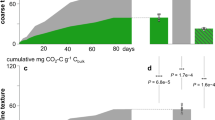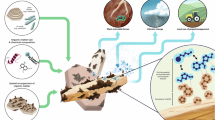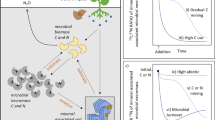Abstract
The stabilization of carbon (C) and nitrogen (N) from organic inputs in soil organic matter constitutes a critical process in ecosystem biogeochemistry, yet the underlying mechanisms are not yet fully understood. Several frameworks have been proposed to explain particulate- and mineral-associated organic matter persistence, but a lack of long-term data has stymied their reconciliation. Here we present the results of an in-field incubation in a grassland in Kansas, USA, that followed 13C- and 15N-labelled plant litter and pyrogenic organic matter through the decomposition process and into soil organic matter fractions over the course of a decade. At the end of the experiment, 7.0% and 24.2% of the initial litter C and N, respectively, remained in the soil, while 60.8% and 54.4% of the initial pyrogenic organic matter C and N, respectively, remained. Litter-derived mineral-associated organic matter formed within the first year of litter decomposition, and 10-year sampling revealed that it had persisted relatively unchanged, in terms of both litter-derived C stocks and C:N ratio. These results provide further evidence that mineral-associated organic matter is stabilized via the sorption of soluble inputs and suggest that stabilization and persistence can occur largely independent of particulate organic matter dynamics.
This is a preview of subscription content, access via your institution
Access options
Access Nature and 54 other Nature Portfolio journals
Get Nature+, our best-value online-access subscription
$32.99 / 30 days
cancel any time
Subscribe to this journal
Receive 12 print issues and online access
$259.00 per year
only $21.58 per issue
Buy this article
- Purchase on SpringerLink
- Instant access to full article PDF
Prices may be subject to local taxes which are calculated during checkout




Similar content being viewed by others
Data availability
The data that support the findings of this study are available via Zenodo at https://doi.org/10.5281/zenodo.14510075 (ref. 46).
Code availability
The code for the calculation, interpretation and visualization of these data is available via GitHub at https://github.com/S-Leuthold/Bluestem_PyOM.
References
Lavallee, J. M. et al. Selective preservation of pyrogenic carbon across soil organic matter fractions and its influence on calculations of carbon mean residence times. Geoderma 354, 113866 (2019).
Huang, Y., Wu, S. & Kaplan, J. O. Sensitivity of global wildfire occurrences to various factors in the context of global change. Atmos. Environ. 121, 86–92 (2015).
Pellegrini, A. F. A. et al. Fire frequency drives decadal changes in soil carbon and nitrogen and ecosystem productivity. Nature 553, 194–198 (2018).
Kleber, M. et al. Chapter one—mineral–organic associations: formation, properties, and relevance in soil environments. In Advances in Agronomy (ed. Sparks, D.) Vol. 130, 1–140 (Elsevier, 2015).
Aber, J. D., Melillo, J. M. & McClaugherty, C. A. Predicting long-term patterns of mass loss, nitrogen dynamics, and soil organic matter formation from initial fine litter chemistry in temperate forest ecosystems. Can. J. Bot. 68, 2201–2208 (1990).
Cotrufo, M. F. & Lavallee, J. M. Chapter one—soil organic matter formation, persistence, and functioning: a synthesis of current understanding to inform its conservation and regeneration. In Advances in Agronomy (ed. Sparks, D.) Vol. 172, 1–66 (Elsevier, 2022).
Six, J., Elliott, E. T. & Paustian, K. Soil macroaggregate turnover and microaggregate formation: a mechanism for C sequestration under no-tillage agriculture. Soil Biol. Biochem. 32, 2099–2103 (2000).
Whalen, E. D. et al. Clarifying the evidence for microbial‐ and plant‐derived soil organic matter, and the path toward a more quantitative understanding. Glob. Change Biol. 28, 7167–7185 (2022).
von Lützow, M. et al. Stabilization mechanisms of organic matter in four temperate soils: development and application of a conceptual model. Z. Pflanzenernähr. Bodenk. 171, 111–124 (2008).
Zhang, Y. et al. Simulating measurable ecosystem carbon and nitrogen dynamics with the mechanistically defined MEMS 2.0 model. Biogeosciences 18, 3147–3171 (2021).
Hicks Pries, C. E., Bird, J. A., Castanha, C., Hatton, P.-J. & Torn, M. S. Long term decomposition: the influence of litter type and soil horizon on retention of plant carbon and nitrogen in soils. Biogeochemistry 134, 5–16 (2017).
Haddix, M. L., Paul, E. A. & Cotrufo, M. F. Dual, differential isotope labeling shows the preferential movement of labile plant constituents into mineral-bonded soil organic matter. Glob. Change Biol. 22, 2301–2312 (2016).
Cotrufo, M. F. et al. Formation of soil organic matter via biochemical and physical pathways of litter mass loss. Nat. Geosci. 8, 776–779 (2015).
Shi, Z. et al. The age distribution of global soil carbon inferred from radiocarbon measurements. Nat. Geosci. 13, 555–559 (2020).
Hatton, P.-J. et al. Transfer of litter-derived N to soil mineral–organic associations: evidence from decadal 15N tracer experiments. Org. Geochem. 42, 1489–1501 (2012).
Dynarski, K. A., Bossio, D. A. & Scow, K. M. Dynamic stability of soil carbon: reassessing the “permanence” of soil carbon sequestration. Front. Environ. Sci. 8, 514701 (2020).
Sanderman, J. et al. Soil organic carbon fractions in the Great Plains of the United States: an application of mid-infrared spectroscopy. Biogeochemistry 156, 97–114 (2021).
Bird, M. I., Wynn, J. G., Saiz, G., Wurster, C. M. & McBeath, A. The pyrogenic carbon cycle. Annu. Rev. Earth Planet. Sci. 43, 273–298 (2015).
Soong, J. L. & Cotrufo, M. F. Annual burning of a tallgrass prairie inhibits C and N cycling in soil, increasing recalcitrant pyrogenic organic matter storage while reducing N availability. Glob. Change Biol. 21, 2321–2333 (2015).
Prescott, C. E., Zabek, L. M., Staley, C. L. & Kabzems, R. Decomposition of broadleaf and needle litter in forests of British Columbia: influences of litter type, forest type, and litter mixtures. Can. J. For. Res. 30, 1742–1750 (2000).
Schmidt, M. W. I. et al. Persistence of soil organic matter as an ecosystem property. Nature 478, 49–56 (2011).
Lehmann, J. et al. Biochar in climate change mitigation. Nat. Geosci. 14, 883–892 (2021).
Soong, J. L. et al. Soil microarthropods support ecosystem productivity and soil C accrual: evidence from a litter decomposition study in the tallgrass prairie. Soil Biol. Biochem. 92, 230–238 (2016).
Li, X. G., Chen, Z. M., Hang Li, X., Ma, Q. & Lin, Y. Chemical characteristics of physically separated soil organic matter fractions in contrasting arable soils. Soil Sci. 178, 128–137 (2013).
Sokol, N. W., Sanderman, J. & Bradford, M. A. Pathways of mineral‐associated soil organic matter formation: integrating the role of plant carbon source, chemistry, and point of entry. Glob. Change Biol. 25, 12–24 (2019).
Liang, C., Schimel, J. P. & Jastrow, J. D. The importance of anabolism in microbial control over soil carbon storage. Nat. Microbiol. 2, 17105 (2017).
Grandy, A. S. & Neff, J. C. Molecular C dynamics downstream: the biochemical decomposition sequence and its impact on soil organic matter structure and function. Sci. Total Environ. 404, 297–307 (2008).
Woolf, D. & Lehmann, J. Microbial models with minimal mineral protection can explain long-term soil organic carbon persistence. Sci. Rep. 9, 6522 (2019).
Fulton-Smith, S. & Cotrufo, M. F. Pathways of soil organic matter formation from above and belowground inputs in a Sorghum bicolor bioenergy crop. GCB Bioenergy 11, 971–987 (2019).
Haddix, M. L. et al. Climate, carbon content, and soil texture control the independent formation and persistence of particulate and mineral-associated organic matter in soil. Geoderma 363, 114160 (2020).
Leuthold, S. J., Haddix, M. L., Lavallee, J. & Cotrufo, M. F. in Reference Module in Earth Systems and Environmental Sciences (eds Goss, M. J. & Oliver, M.) Vol. 2, 68–80 (Elsevier, 2022).
Samson, M.-É., Chantigny, M. H., Vanasse, A., Menasseri-Aubry, S. & Angers, D. A. Coarse mineral-associated organic matter is a pivotal fraction for SOM formation and is sensitive to the quality of organic inputs. Soil Biol. Biochem. 149, 107935 (2020).
See, C. R. et al. Hyphae move matter and microbes to mineral microsites: integrating the hyphosphere into conceptual models of soil organic matter stabilization. Glob. Change Biol. 28, 2527–2540 (2022).
Witzgall, K. et al. Particulate organic matter as a functional soil component for persistent soil organic carbon. Nat. Commun. 12, 4115 (2021).
Ridgeway, J., Kane, J., Morrissey, E., Starcher, H. & Brzostek, E. Roots selectively decompose litter to mine nitrogen and build new soil carbon. Ecol. Lett. https://doi.org/10.1111/ele.14331 (2023).
Hilscher, A. & Knicker, H. Degradation of grass-derived pyrogenic organic material, transport of the residues within a soil column and distribution in soil organic matter fractions during a 28month microcosm experiment. Org. Geochem. 42, 42–54 (2011).
Schiedung, M., Bellè, S.-L., Sigmund, G., Kalbitz, K. & Abiven, S. Vertical mobility of pyrogenic organic matter in soils: a column experiment. Biogeosciences 17, 6457–6474 (2020).
Singh, N. et al. Transformation and stabilization of pyrogenic organic matter in a temperate forest field experiment. Glob. Change Biol. 20, 1629–1642 (2014).
Sanderman, J. & Grandy, A. S. Ramped thermal analysis for isolating biologically meaningful soil organic matter fractions with distinct residence times. SOIL 6, 131–144 (2020).
Rocci, K. et al. Bridging 20 years of soil organic matter frameworks: empirical support, model representation, and next steps. ESS Open Archive https://essopenarchive.org/users/707198/articles/693182-bridging-20-years-of-soil-organic-matter-frameworks-empirical-support-model-representation-and-next-steps?commit=6f9f36c5a7b3345dc25a2fd1a830ee968ff040e9 (2023).
Soong, J. L. et al. Design and operation of a continuous 13C and 15N labeling chamber for uniform or differential, metabolic and structural, plant isotope labeling. J. Vis. Exp. https://doi.org/10.3791/51117 (2014).
R Core Team. R: A Language and Environment for Statistical Computing (R Project, 2022).
Bates, D., Mächler, M., Bolker, B. & Walker, S. Fitting linear mixed-effects models using lme4. J. Stat. Soft. 67, 1–48 (2015).
Kuznetsova, A., Brockhoff, P. B. & Christensen, R. H. B. lmerTest package: tests in linear mixed effects models. J. Stat. Softw. https://doi.org/10.18637/jss.v082.i13 (2017).
Lenth, R. V. emmeans: estimated marginal means, aka least-squares means (2022).
Leuthold, S. J., Soong, J. L., Even, R. J. & Cotrufo, M. F. Data associated with Leuthold et al.—“Decadal persistence of grassland soil organic matter derived from litter and pyrogenic inputs.” Zenodo https://doi.org/10.5281/zenodo.14510075 (2024).
Acknowledgements
This work was funded by NSF-DEB award number 2016003 (M.F.C.) and USDA NIFA award number 2021-67019-34241 (M.F.C.). We thank K. Rocci and A. Prairie for their assistance in data collection, and the staff of the Konza Prairie LTER site for their support in the establishment and maintenance of the experiment for its duration.
Author information
Authors and Affiliations
Contributions
M.F.C. and J.L.S. designed the study. R.J.E. and J.L.S. performed the laboratory analyses. S.J.L. performed the data analysis. All authors contributed to the interpretation of results. S.J.L. wrote the paper with input from all authors.
Corresponding author
Ethics declarations
Competing interests
M.F.C. and R.J.E. declare the following competing interests: they are cofounders of Cquester Analytics LLC, a service analytical facility that provides the analyses of SOM. The other authors declare no competing interests.
Peer review
Peer review information
Nature Geoscience thanks Sarah O’Brien and the other, anonymous, reviewer(s) for their contribution to the peer review of this work. Primary Handling Editor: Stefan Lachowycz, in collaboration with the Nature Geoscience team.
Additional information
Publisher’s note Springer Nature remains neutral with regard to jurisdictional claims in published maps and institutional affiliations.
Extended data
Extended Data Fig. 1 Evidence of down-profile transfer of isotopically enriched material over the course of the incubation period.
The amount of enriched PyOM material in the top 2 cm decreased over the incubation period (-41%), while the amount of PyOM in the 2-5 cm and 5-10 cm depth increments increased (130% and 353%, respectively). While our sampling was limited to 10 cm at the final harvest, this pattern suggests that down profile movement of the PyOM is an important loss mechanism of PyOM in grassland systems. Bar height represents the cumulative mean (n = 4), error bars are equal to the mean +/- 1 SE.
Supplementary information
Supplementary information
Supplementary Figs. 1–3, discussion and Table 1.
Rights and permissions
Springer Nature or its licensor (e.g. a society or other partner) holds exclusive rights to this article under a publishing agreement with the author(s) or other rightsholder(s); author self-archiving of the accepted manuscript version of this article is solely governed by the terms of such publishing agreement and applicable law.
About this article
Cite this article
Leuthold, S.J., Soong, J.L., Even, R.J. et al. Decadal persistence of grassland soil organic matter derived from litter and pyrogenic inputs. Nat. Geosci. 18, 226–231 (2025). https://doi.org/10.1038/s41561-025-01638-y
Received:
Accepted:
Published:
Issue date:
DOI: https://doi.org/10.1038/s41561-025-01638-y



